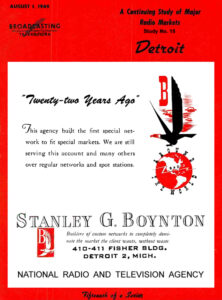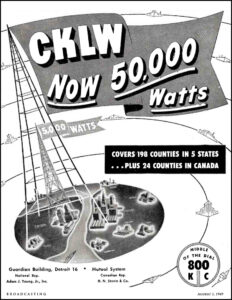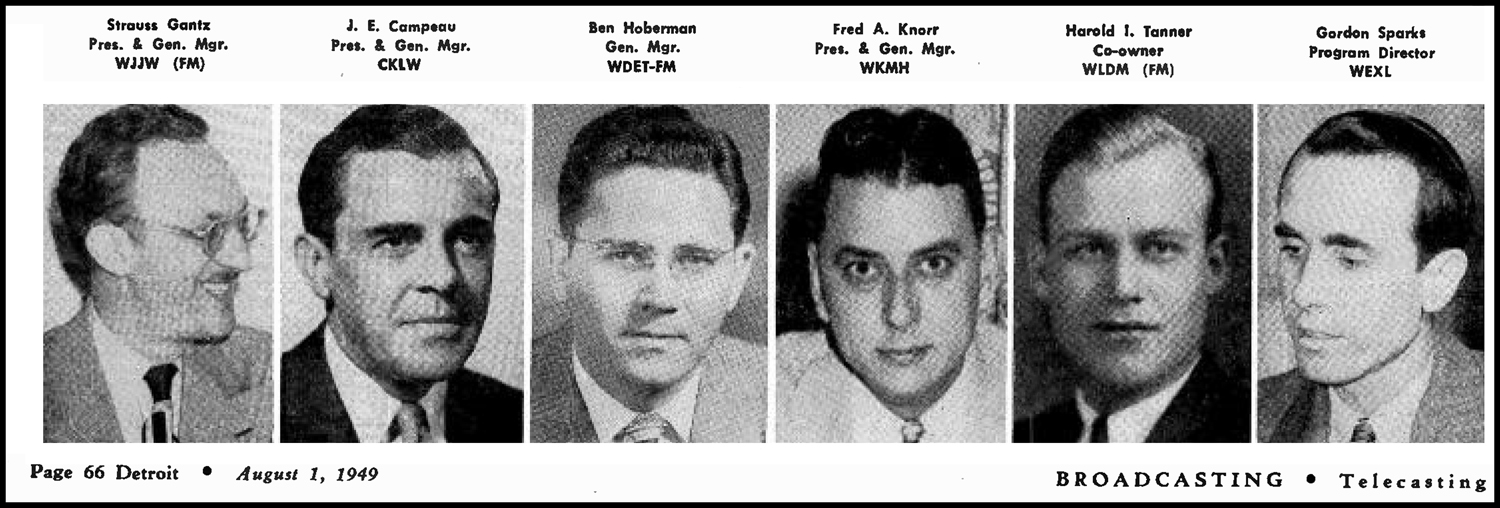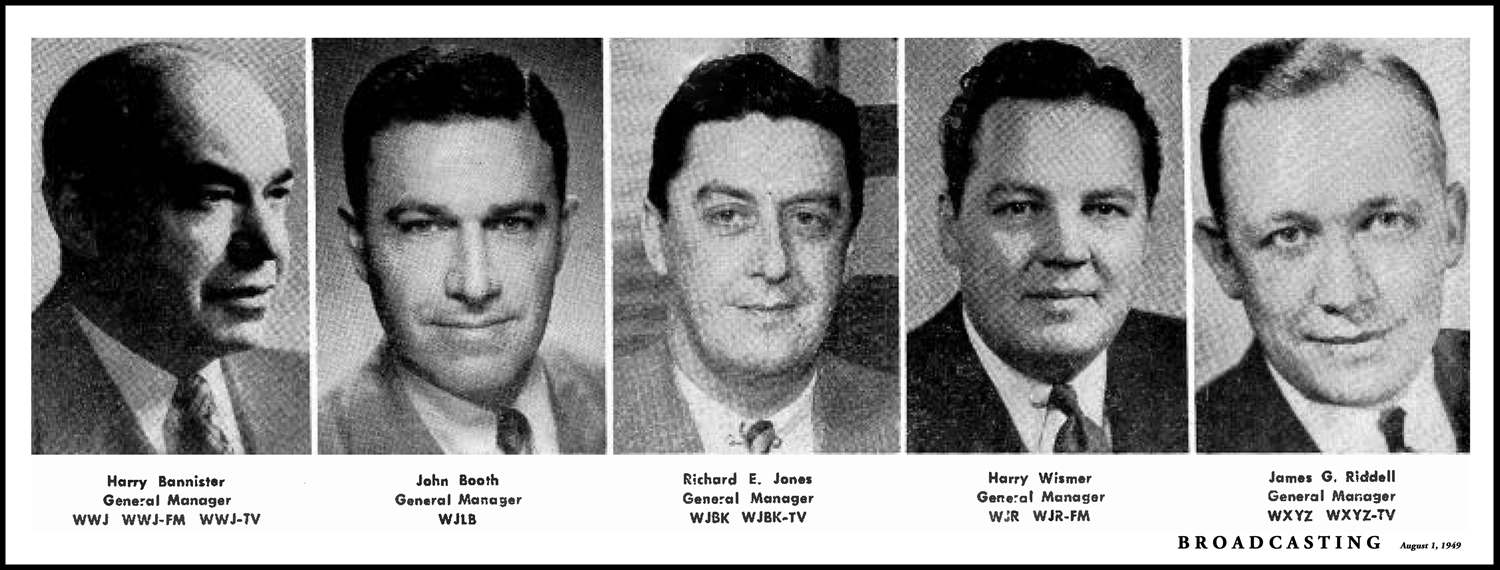 75 Years Ago, August 1, Broadcasting Magazine Reported In-Depth On the Status of the Radio Market in Detroit — Final Chapter – Part 6
75 Years Ago, August 1, Broadcasting Magazine Reported In-Depth On the Status of the Radio Market in Detroit — Final Chapter – Part 6
 Note: Missed Chapter Five? Go HERE.
Note: Missed Chapter Five? Go HERE.
_____________________
Detroit is headquarters for one of the country’s largest producers of TV visual presentations in the Jam Handy Organization. The TV department of this company was set up prior to 1941 by Jamison Handy, president, utilizing all the facilities which had been built up over 30 years in the field of visual training and commercial motion pictures, including production facilities in New York and Hollywood, as well as Detroit.

A citation for the “skilled application of commercial techniques to television” was made by the Television Broadcasters Association for the TV commercials of Lucky Strike, produced by the company. In addition, CCNY presented N. W. Ayer & Sons Inc. their 1949 award of merit for creating the most effective spot television announcement. This award was for the Lucky Strike Square Dance commercial produced by Jam Handy. Other Jam Handy TV commercial buyers are Chevrolet, Oldsmobile, Curtis Publishing, Gruen Watch, and Standard Oil of N. J.
All of the Detroit stations except WKMH offer simultaneous FM with AM broadcasts. WWJ-FM is one of the earliest stations in the country. In 1936, it began broadcasting in this medium which was so new that a News editorial said at the time:
 “The News is happy to assist in the revival of a craft which has languished with the perfection of commercial radio sets, the building at home of receivers suited to the new frequencies. A few of these are now manufactured, and their names or advice and plans for the home construction of sets of the same sort, we shall put at the public’s disposal.”
“The News is happy to assist in the revival of a craft which has languished with the perfection of commercial radio sets, the building at home of receivers suited to the new frequencies. A few of these are now manufactured, and their names or advice and plans for the home construction of sets of the same sort, we shall put at the public’s disposal.”
With FM receivers in the Detroit area estimated at 150,000, the three FM-only broadcasters are working hard at their specialized task, using music, news, and especially strong local programming of live talent. WLDM-FM was recently appointed Detroit outlet for the Michigan FM Network, which give it access to a continuing series of concerts from the U. of Michigan, plus the programming of the other 30 FM stations in the network. The Lincoln Broadcasting Co. owns and operates WLDM.
[Note: Mouse click over (pc) or tap and stretch (mobile screen) over the CKLW ad and all images for largest detailed read.]
WDET (FM), which was established in January of this year by the executive board of the UAW-CIO, works closely with many civic groups plus the many auto worker locals. It is especially forward in presenting programs on controversial subjects. During the recent Ford strike, the station offered its facilities to both the company and the union to present their sides of the controversy. Ben Hoberman is station manager.
Strauss Gantz, head of WJJW (FM) in downriver Wyandotte, is another avid supporter of FM, and said this about broadcasting:
“Radio, either FM or AM, without good local programming, serves no public purpose, and becomes either a glorified jukebox or merely a relay point.”
![]()

![]() Since Detroit was hooked up to the eastern coaxial cable in January, the growth of television in this area has been rapid. The latest estimate of the number of sets by the Detroit Edison Co. is over 60,000, and TV men confidently expect to hit 100,000 by year-end. The three stations each opened in a blaze of publicity, getting editorial and advertising support from the Detroit newspapers, each of which put out a TV section at different times. Advertisers, especially the key auto men, have been eager to try to do a good selling job via the new medium.
Since Detroit was hooked up to the eastern coaxial cable in January, the growth of television in this area has been rapid. The latest estimate of the number of sets by the Detroit Edison Co. is over 60,000, and TV men confidently expect to hit 100,000 by year-end. The three stations each opened in a blaze of publicity, getting editorial and advertising support from the Detroit newspapers, each of which put out a TV section at different times. Advertisers, especially the key auto men, have been eager to try to do a good selling job via the new medium.
![]()

![]() All four TV networks are represented in Detroit. WWJ-TV is outlet for NBC, WXYZ-TV for ABC, and WJBK-TV handles DuMent and CBS. There is FCC authorization for another channel, with several applications pending.
All four TV networks are represented in Detroit. WWJ-TV is outlet for NBC, WXYZ-TV for ABC, and WJBK-TV handles DuMent and CBS. There is FCC authorization for another channel, with several applications pending.
As expected, the auto men jumped into television with the opening of the first station in the city. The fact that here was a way of actually showing the product along with a spoken sales talk caused a rush to TV by both local dealers and national companies. One station, WXYZ-TV, had an eight-foot opening cut into its studio wall so automobiles could be driven directly onto the stage for commercials. END
_____________________
MCRFB Note: This chapter finalizes The Detroit Radio Market report (presented here in six parts) first published by Broadcasting, August 1, 1949.
 This article will conclude our weekly special series on Detroit radio from Broadcasting magazine, from August 1, 1949.
This article will conclude our weekly special series on Detroit radio from Broadcasting magazine, from August 1, 1949.
This feature was a special Broadcasting series about Detroit radio, first published, August 1, 1949. The complete article was republished on this site, Tuesdays, throughout August and September for a total of six weeks.
Originally published in Broadcasting magazine under the title “The Detroit Radio Market,” this extensive article was presented in full in six parts, in sequential chapters.
The 1949 article provides valuable insights into the state of radio in Detroit during the late 1940s decade, as it was, then, seven decades ago.
![]()





Marvelous……